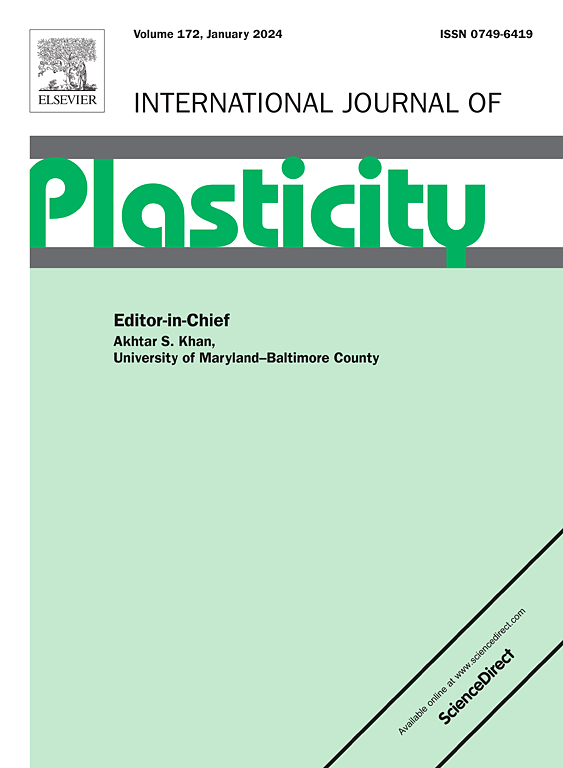Zirconium δ-Hydrides: Strain Localisation, Ratcheting, and Fatigue Crack Propagation
IF 9.4
1区 材料科学
Q1 ENGINEERING, MECHANICAL
引用次数: 0
Abstract
As many nations commit to achieving Net Zero, many low carbon scenarios indicate that civil nuclear power generation and the economics thereof are set to play a vital role. To maximise nuclear reactor operation lifetimes, it is essential to develop mechanistic understanding of failure and degradation mechanisms in safety-critical components for increasingly holistic reactor design codes and standards. In this paper, advanced micromechanical testing with in situ digital image correlation is used in combination with crystal plasticity modelling to study various aspects of damage associated with δ hydride precipitates in Zircaloy-4 for reactor fuel cladding applications. Measurements of static and cyclic hydride precipitation strains demonstrate a discernible strain field directionality (associated with intragranular precipitation) which was not previously reported, while cyclic thermomechanical loads are shown to promote the cyclic accumulation of strain due to repeated precipitation and dissolution of hydrides (hydride strain ratcheting) for up to five cycles, leading to the development of networks of geometrically necessary dislocations. Using crystal plasticity finite element modelling of the volumetric expansion associated with hydride precipitation, the strain directionality phenomenon is shown to be linked with hydride morphology. Comparisons with experimental strain fields also suggest that hydride plasticity is an important consideration for damage accumulation during precipitation. Experimental measurements of short fatigue crack propagation through Zircaloy-4 microstructures containing hydrides reveal new crack propagation mechanisms including decohesion, which on average, lead to accelerated rates of crack growth. Annealing twins and hydride precipitation therein are also implicated in even more damaging fatigue behaviour as fatigue cracks are provided a seemingly brittle and direct path for fracture, which was not previously reported in the literature.锆δ-氢化物:应变局部化、棘轮和疲劳裂纹扩展
随着许多国家致力于实现净零排放,许多低碳情景表明,民用核能发电及其经济性将发挥至关重要的作用。为了最大限度地延长核反应堆的运行寿命,为日益全面的反应堆设计规范和标准,发展对安全关键部件失效和退化机制的机械理解是至关重要的。在本文中,采用先进的微力学测试与原位数字图像相关,结合晶体塑性建模,研究了反应堆燃料包壳应用中锆合金-4中δ氢化物沉淀相关的各个方面的损伤。静态和循环氢化物析出应变的测量表明,应变场有明显的方向性(与颗粒内析出有关),这是以前没有报道过的,而循环热机械载荷显示,由于氢化物的反复析出和溶解(氢化物应变棘齿),可促进应变的循环积累,长达五个周期,导致几何上必要的位错网络的发展。通过对氢化物析出过程中体积膨胀的晶体塑性有限元模拟,表明应变方向性现象与氢化物形态有关。与试验应变场的比较也表明,氢化物塑性是影响沉淀过程中损伤积累的重要因素。通过含氢化物的锆合金-4微结构的短疲劳裂纹扩展实验测量揭示了新的裂纹扩展机制,包括脱黏,平均而言,这导致裂纹扩展速度加快。退火孪晶和其中的氢化物沉淀也涉及到更具破坏性的疲劳行为,因为疲劳裂纹提供了一个看似脆的直接断裂路径,这在以前的文献中没有报道过。
本文章由计算机程序翻译,如有差异,请以英文原文为准。
求助全文
约1分钟内获得全文
求助全文
来源期刊

International Journal of Plasticity
工程技术-材料科学:综合
CiteScore
15.30
自引率
26.50%
发文量
256
审稿时长
46 days
期刊介绍:
International Journal of Plasticity aims to present original research encompassing all facets of plastic deformation, damage, and fracture behavior in both isotropic and anisotropic solids. This includes exploring the thermodynamics of plasticity and fracture, continuum theory, and macroscopic as well as microscopic phenomena.
Topics of interest span the plastic behavior of single crystals and polycrystalline metals, ceramics, rocks, soils, composites, nanocrystalline and microelectronics materials, shape memory alloys, ferroelectric ceramics, thin films, and polymers. Additionally, the journal covers plasticity aspects of failure and fracture mechanics. Contributions involving significant experimental, numerical, or theoretical advancements that enhance the understanding of the plastic behavior of solids are particularly valued. Papers addressing the modeling of finite nonlinear elastic deformation, bearing similarities to the modeling of plastic deformation, are also welcomed.
 求助内容:
求助内容: 应助结果提醒方式:
应助结果提醒方式:


